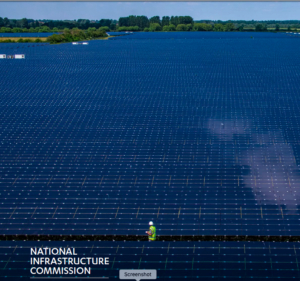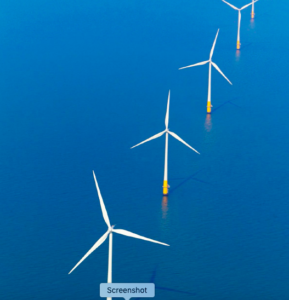When one thinks of “infrastructure,” it does not suggest drama, excitement, colorful characters, fame and fortune. It is more like a thud. Yet the Forward to the first report on the UK National Infrastructure Assessment (July 2018) very quickly raises some interest:
Over the last 50 years, the UK has seen an endless cycle of delays, prevarication and uncertainty. These have been driven in part by short term considerations, and the lack of a cross-sectoral approach to infrastructure. This approach has limited growth, undermined job certainty, and restricted innovation. And too often the UK has ended up playing catch up. This will not do for the challenges ahead.
The language may not be very concrete but it is forceful and signals a report that might not pull punches when it assesses what has been happening with infrastructure in the UK, and what should be happening if the UK economy and resilience to climate change are to survive what lies ahead.

Infrastructure (literally, the structure below or underlying) includes well-known features of our daily lives, including modes of transport (bridges, roads, railroads, subways, trams, airplanes, ports and the stations for each); water supplies and sewers, flooding defenses; and energy grids. We can also add a newer form of infrastructure: the internet, including access to it and its capabilities, like size and speed. Some of these things are not readily visible (sewers and water lines) and the others may be visible but they are so much a part of our day-to-day lives that we pay them no mind. Advertising billboards are more likely to grab our attention.
Interestingly, Goldman Sachs defines “infrastrucure” as having the following characteristics: provides an essential service to society; typically has high barrier to entry; can be regulated; is resilient. It also notes that contemporary forms of infrastructure include fiber IT communication networks (modern forms of roads); eCommerce; eVehicles; and urban concentration with necessary smart cities enabled by internet.
Our lives would be much the poorer and challenging if these traditional and contemporary forms of infrastructure did not work or fell apart. As they do from time to time. That is what worries the UK National Infrastructure Commission, the author of the report.
The report provides a long-term strategy for the UK economic infrastructure from 2020 to 2050. The report focuses on three challenges, or priorities, for infrastructure — congestion, capacity and carbon — and produces a number of specific major recommendations.
Building a Digital Society
Economic growth does now and will continue to depend on data and digital technology to connect customers, information, and suppliers. Artificial intelligence and the internet will feed developments in fields such as driverless vehicles and health services with expanding online access to medical specialists.

While the UK has developed an extensive broadband network, the Commission makes it clear that this is not enough. Technology is pushing the limits and capabilities of the internet and superfast broadband is no longer enough. The Commission recommends that the government deliver full fibre across the country as it is more reliable and cheaper to maintain than the current part fibre, part copper broadband. That shift to full fibre should be planned now and implemented fully by 2033 in order to keep pace with the digital economy, especially with the development of smart infrastructure. Market competition should suffice to provide full fibre in most urban areas, while some subsidy will be necessary in less dense or isolated areas.
Low Cost, Low Carbon Power
In light of the technological developments over the past decade, the Commission recommends an electricity system running on at least 50% renewable energy by 2030. Importantly, the cost of developing a highly renewable mix is low cost, and comparable to building further nuclear power plants after Hinkley Point C and cheaper than carbon capture and storage. The Commission advises against support for more than one nuclear power station beyond Hinkley Point C before 2025. To support this development of renewables, it will be necessary to increase flexibiity in the energy system and it is recommended that the government rely on existing market mechanisms, including contracts for difference.
Developing low cost, low carbon for heating is a real challenge and the Commission has determined that energy efficiency is a first step in this direction. Second, hydrogen should be developed to replace natural gas, and carbon capture and storage and heat pumps also need support.

As for waste, the Commission found public support for greater recycling but confusion in the public about the process. Areas that are prime for expansion are food waste, which can be processed in anaerobic digesters instead of sent to incinerators, and of course recycling of plastics and limits on hard-to-recycle plastics. Tougher recycling targets are required including 65% of municipal waste and 75% of plastic packaging.
Revolutionising Road Transport
The Commission notes that road transport will not be recognizable by 2050: cars and vans will be electric and increasingly autonomous. To encourage the take up of e-cars the government needs to expand access to charging stations and require local authorities to make available up to 5% of their parking spaces for charge points by 2020, and 25% by 2025. Where the private sector is lagging in establishing charge points, the government needs to provide subsidies for those areas.
Besides electric cars and vans, the transport sector will be transformed by connected and autonomous vehicles, which likely will promote vehicle sharing and reduced car ownership. Traffic lights may be unnecessary, speed limits may increase, and use of road space will keep shifting as a result of these new technologies. Since road and rail projects take decades to implement and last for decades, the government needs to adopt these transformations as part of its current planning.
Transport and housing for thriving city regions: congestion
With a global migration to urban centers, the government must be prepared for increased congestion that can undermine economic growth. Transport does not account for growth in itself, but urban transport must be able to enable growth and not retard it. The government must now develop fast, frequent public transport systems, as well as affordable housing connected to the public transport system. And public park spaces are needed in these congested urban environments.
Reducing the risks of drought and flooding
There are no surprises in predicting the increase in extreme weather events, especially flooding and drought, and the need for decisive action now. What is helpful is that the report offers specific targets for such action. It also has determined that the flood protection plans should be based on catchments, which makes sound sense.

The Commission found that the nationalstandard for resilience to flooding should be set a likelihood of 0.5% per year by 2050,
where feasible, and over longer periods those standards should be tightened. Even now in densely populated areas, where the risks of flooding are more consequential, the resilence to flooding should be set at a likelihood of only 0.1% a year by 2050. To prepare for these targets the Environment Agency should update catchment plans by 2023.
While chances of flooding will rise, usable water will become more scarce. The Commission points out that despite the UK reputation for rain, the UK has ignored the growing risk of water shortages, especially in the south east of England. The shortcomings in addressing water shortages includes the limited cooperation between water companies and a reliance on short-term planning. To address these issues, the Commission points to its recommendations in an earlier standalone report it produced, Preparing for a drier future: England’s water infrastructure needs. Those recommendations include developing a national water transfer network, additional water supply (e.g., reservoirs, water re-use), cutting leaks in half by 2050, and smart metering.
Funding and financing
The Commission developed its recommendations in light of the government’s requirement that their estimated costs should be no more than 1.0 to 1.2 % of GDP (including already approved major infrastructure projects). Of course there are many uncertainties in any such estimations. Several are noted by the Commission. For instance, the shift to eVehicles will result in a drop in fuel duty revenues. As this develops, it is time to revisit an issue that has received attention in the past but never been resolved. That is the issue of road pricing — how road users pay to use roads. The Commission urges that now is the time to design a system of road taxation that is fairer, more sustainable, and more effective at reducing the adverse effects of driving and that gets wider public support. Also in need of further refinement is the system whereby developers contribute to the cost of infrastructure associated with their projects.
Conclusion
We suggested at the beginning that this report might not pull punches when addressing the government’s obligations to take proactive and immediate action in order to prepare critical infrastructure for the unfolding challenges that are complicated by climate change. The report does deliver some well-deserved punches.
The Commission’s reservations about the limited usefulness of nuclear and natural gas will present interesting challenges for a UK government that is promoting fracked natural gas and nuclear power. A call for a full fibre internet rollout across the UK is ambitious.
The Commission also points out that Brexit, or the withdrawal of the UK from the EU, will have consequences for infrastructure. For instance, much work on infrastructure is funded by the European Investment Bank and that source will dry up with Brexit. Similarly, successful infrastructure improvements require a steady supply chain and a skilled work force. Both are in jeopardy in the case of Brexit.
The Commission notes that the government is obliged to present the Commission’s report and recommendations before Parliament, to provide a final response to the Infrastructure Assessment within a year, and to lay out which recommendations it agrees with and which not, with specific alternatives for those it does not agree with. In return, the Commission commits to its duty to continue to monitor the government’s progress (or lack thereof) and report on it.
Finally, the Commission notes that of the issues it addresses in the report, only energy in Great Britain and digital communications in the UK remain the responsibility of the UK government. All other issues have been devolved to the administration in Northern Ireland, Scotland and Wales. The Commission’s role is to advise the UK government but it works with the devolved administrations where responsibilities overlap. At 16.
Sources:
National Infrastructure Commission, National Infrastructure Assessment (July 2018). bit.ly/2J9dqnK
National Infrastructure Commission, Preparing for a drier future: England’s water infrastructure needs (April 2018).
bit.ly/2CwdfmA
Goldman Sachs, The Evolving Infrastructure Landscape (1 Nov 2018) (video). bit.ly/2QJFbMu


No comments yet, add your own below